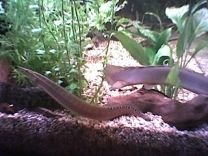Common name/s: Peacock spiny eel
Scientific name: Macrognathus aculeatus
Family: Mastacembelidae
Origin: Common throughout south east asia
Maximum size: 14"
Care: The smallest of the commonly seen spiny eels (tyre track and fire eels being the others) it is more suitable for home aquariums than its giant relatives, a minimum of a 36" tank should be used to house this fish. Offer a sand substrate since the fish likes to burrow, plants are best left out since the eel/s will continually uproot them. Being predators they should only be combined with fish that are over 3", smaller fish will be eaten. They are not fussy of water parameters but the extreems of hardness and pH should be avoided, neutral water is best.
Feeding: Like with all eels feeding can be difficult, most eels will only accept live foods at first so try bloodworms, daphnia, glassworm, brineshrimp and black mosquito larvea, larger specimins should also take river/ghost shrimp. Once the eel is feeding confidently live foods can be swapped for frozen.
Breeding: Difficult but possible, i have witnessed my 3 peacock spiny eels spawning on two occasions but neither time had a breeding tank prepared (also if you have ever tried to catch a spiny eel in a well furnished tank you will know that it is near impossible). The two male eels pursued the female (identified as being the larger more rounded of the trio) around the tank while she dropped many small clear eggs on the substrate and decor, the eggs were immiedietly eaten by other fish in the tank. The spawning triggers each time seem to be linked to large feedings of live foods and large water changes.
Comments: Unlike other spiny eels peacocks appear to like the company of their own kind, if possible keep a small group of them.

Scientific name: Macrognathus aculeatus
Family: Mastacembelidae
Origin: Common throughout south east asia
Maximum size: 14"
Care: The smallest of the commonly seen spiny eels (tyre track and fire eels being the others) it is more suitable for home aquariums than its giant relatives, a minimum of a 36" tank should be used to house this fish. Offer a sand substrate since the fish likes to burrow, plants are best left out since the eel/s will continually uproot them. Being predators they should only be combined with fish that are over 3", smaller fish will be eaten. They are not fussy of water parameters but the extreems of hardness and pH should be avoided, neutral water is best.
Feeding: Like with all eels feeding can be difficult, most eels will only accept live foods at first so try bloodworms, daphnia, glassworm, brineshrimp and black mosquito larvea, larger specimins should also take river/ghost shrimp. Once the eel is feeding confidently live foods can be swapped for frozen.
Breeding: Difficult but possible, i have witnessed my 3 peacock spiny eels spawning on two occasions but neither time had a breeding tank prepared (also if you have ever tried to catch a spiny eel in a well furnished tank you will know that it is near impossible). The two male eels pursued the female (identified as being the larger more rounded of the trio) around the tank while she dropped many small clear eggs on the substrate and decor, the eggs were immiedietly eaten by other fish in the tank. The spawning triggers each time seem to be linked to large feedings of live foods and large water changes.
Comments: Unlike other spiny eels peacocks appear to like the company of their own kind, if possible keep a small group of them.








